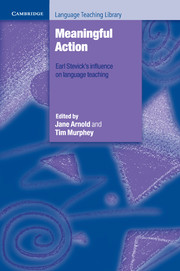Book contents
- Frontmatter
- Contents
- List of contributors
- Acknowledgements
- Preface
- Introduction
- Part A Meaning-making inside and between the people in the classroom
- Part B Meaningful classroom activity
- Part C Frameworks for meaningful language learning
- Epilogue: A way with words – perspectives on the contributions and influence of Earl W. Stevick
- Appendix: Words of tribute to Earl Stevick
- Index
14 - Renting language in the ownership society: reflections on language use and language learning in a multilingual world
Published online by Cambridge University Press: 15 November 2023
- Frontmatter
- Contents
- List of contributors
- Acknowledgements
- Preface
- Introduction
- Part A Meaning-making inside and between the people in the classroom
- Part B Meaningful classroom activity
- Part C Frameworks for meaningful language learning
- Epilogue: A way with words – perspectives on the contributions and influence of Earl W. Stevick
- Appendix: Words of tribute to Earl Stevick
- Index
Summary
Introduction
Re-reading some of Earl W. Stevick's publications in anticipation of contributing to this volume, I was struck again by the central role he accorded to what he refers to as ‘humanistic’ language teaching and learning. That focus is unmistakably stated in the title of one of his late works, Humanism in Language Teaching (1991). But an interest in ‘humanistic’ approaches had long permeated his scholarly output. Thus, the preface to Memory, Meaning and Method: Some Psychological Perspectives on Language Learning (1976) reiterated a belief that he had already stated earlier on, namely that language study was to be regarded as a ‘total human experience’, as being oriented towards the whole person who is acting and interacting in the classroom. Accordingly, while the opening sections of that book dealt with the biological bases of memory and diverse experiments on verbal memory and verbal learning, Stevick left little doubt in the treatment of ‘meaning’ and ‘method’ in the remainder of the volume that his real concern was, to use his plain-spoken, memorable phrasing, with ‘what goes on inside and between folks’ (1976: 119).
That turn of phrase provides a useful first-hand characterization of the intended focus. Even so, reference to this interest as being ‘humanist’ or indicating ‘humanism’ might, in light of current use, appear to be somewhat oddly placed, perhaps even overstated. However, Stevick's publications, especially Teaching Languages: A Way and Ways (1980) and his responses to diverse interpretations, over-interpretations and misinterpretations of that work by contemporary scholarship (see Stevick 1983 and other contributions in Clarke and Handscombe 1983), are unequivocal in the matter. To him, Teaching Languages presented an expansive personal reflection on three contemporary teaching methods that, despite their differences, were unified by what he called their ‘humanistic’ approach: Gattegno's the Silent Way, Curran's Counselling-Learning / Community Language Learning and Lozanov's Suggestopedia (see Maley, this volume).
What makes them ‘humane’ or ‘humanist’ is the central role they accord in the processes of teaching and learning to learners’ feeling, both emotional and aesthetic; to social relations, including friendship and cooperation; to responsibility; to critical reasoning abilities; and to self-actualization that pursues a path towards individuality.
- Type
- Chapter
- Information
- Meaningful ActionEarl Stevick's Influence on Language Teaching, pp. 222 - 240Publisher: Cambridge University PressPrint publication year: 2013
- 4
- Cited by



